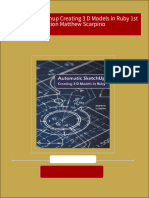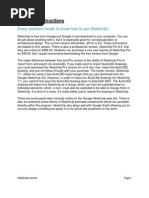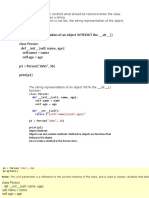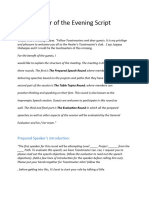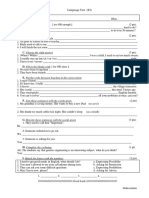0%(1)0% found this document useful (1 vote)
157 viewsExample Scripts
The document provides examples of how to use the Ruby programming language to interact with and modify a SketchUp 3D modeling program. It includes examples of creating geometry, selecting entities, adding custom menu items, creating tools, animations, and managing entity attributes.
Uploaded by
bp1212123552Copyright
© © All Rights Reserved
Available Formats
Download as TXT, PDF, TXT or read online on Scribd
0%(1)0% found this document useful (1 vote)
157 viewsExample Scripts
The document provides examples of how to use the Ruby programming language to interact with and modify a SketchUp 3D modeling program. It includes examples of creating geometry, selecting entities, adding custom menu items, creating tools, animations, and managing entity attributes.
Uploaded by
bp1212123552Copyright
© © All Rights Reserved
Available Formats
Download as TXT, PDF, TXT or read online on Scribd
You are on page 1/ 3
# Copyright 2012, Trimble Navigation Limited
# This software is provided as an example of using the Ruby interface
# to SketchUp.
# Permission to use, copy, modify, and distribute this software for
# any purpose and without fee is hereby granted, provided that the above
# copyright notice appear in all copies.
# THIS SOFTWARE IS PROVIDED "AS IS" AND WITHOUT ANY EXPRESS OR
# IMPLIED WARRANTIES, INCLUDING, WITHOUT LIMITATION, THE IMPLIED
# WARRANTIES OF MERCHANTABILITY AND FITNESS FOR A PARTICULAR PURPOSE.
#-----------------------------------------------------------------------------
# This file includes a number of examples of how to use the Ruby interface
# to access a SketchUp model and perform various kinds of operations.
# To test the examples you must first load the files.
# There are two ways that you can do this.
# The first way is to manually load it from the Ruby console. You can show
# the Ruby console by selecting View/Ruby Console. (This is actually added
# to the View menu when the Ruby script sketchup.rb is loaded.) In the
# Ruby console, type the following line:
# load 'examples/examples.rb'
# If there are no syntax errors in the file, it will display "true" in the
# Ruby console. Otherwise it will show error messages and information about
# the line on which errors were found.
# The second way to load this file is to copy it into the SketchUp plugins
# directory. Any files with the extension .rb that are in the plugins
# directory are automatically loaded when you start SketchUp.
# The following line includes some common useful scripts. The file
# sketchup.rb is automatically put in the SketchUp plugins directory
# when SketchUp is installed, so it should always get automatically
# loaded anyway, but it is good practice to explicitly require any
# files that you have dependencies on to make sure that they are loaded.
require 'sketchup.rb'
#-----------------------------------------------------------------------------
# box.rb is an example of how to create simple geometry using Ruby.
# It also shows how to create a dialog box to prompt for user input
# and how to add an item to a menu.
require 'examples/box.rb'
#-----------------------------------------------------------------------------
# selection.rb has a number of examples of how to traverse the model and
# select things in Ruby.
require 'examples/selection.rb'
#-----------------------------------------------------------------------------
# contextmenu.rb shows how you can add new choices to context menus. It
# adds an item to the context menu for arcs and circles to create a
# point at the center of the arc.
require 'examples/contextmenu.rb'
#-----------------------------------------------------------------------------
# linetool.rb shows how you can create tools that respond to mouse event
# in Ruby. It defines a simple tool that behave similar to the pencil
# tool in SketchUp except that it creates finite length construction lines
# instead of regular SketchUp edges
require 'examples/linetool.rb'
#-----------------------------------------------------------------------------
# animation.rb has an example of how you can create animations in Ruby.
# It creates a simple animation that spins the view around.
require 'examples/animation.rb'
# attributes.rb shows how to attach arbitrary application specific attribute
# data to SketchUp Entities.
require 'examples/attributes.rb'
#=============================================================================
# This will set the layer of everything that is selected to
# a layer with the given name. It will create a new layer if needed
def setLayer(layerName)
model = Sketchup.active_model
ss = model.selection
if( ss.empty? )
return nil
end
# If there is alread a Layer with the given name, the add method on the
# Layers object will return the existing Layer. Otherwise it will
# create a new one and return it.
layer = model.layers.add(layerName)
# now iterate through everything that is selected and set its layer
for ent in ss
ent.layer = layer
end
# Here is another way that you could do the same thing
#ss.each {|ent| ent.layer = layer}
end
#-------------------------------------------------------------------------
# compute the total area of all faces
def totalArea
area = 0
model = Sketchup.active_model
# this shows a different syntax for iterating through the model
model.entities.each { |ent| area += ent.area if( ent.is_a? Sketchup::Face )
}
# here is a different way you could do it
# for ent in model.entities
# if( ent.is_a? Sketchup::Face )
# area += ent.area
# end
# end
area
end
#-------------------------------------------------------------------------
# Get the perimeter of the selected faces
def perimeter
length = 0
edges = []
# First collect all of the edges that bound all of the selected faces.
model = Sketchup.active_model
ss = model.selection
for ent in ss
if( ent.is_a? Sketchup::Face )
edges.concat ent.edges
end
end
# remove duplicate edges
edges.uniq!
# sum the lengths of all of the edges
edges.each {|e| length += e.length}
length
end
#-----------------------------------------------------------------------------
# SketchUp sets up Ruby to look for files in its plugins directory when you
# use the load command. You can add additional directories to its search path.
# This can be useful when you are developing new scripts because it can
# make it easier to load them during testing.
# This command adds your home directory to the search path. Note that this
# only works if the environment variable HOME is defined.
# $: is a special system variable in Ruby that defines the search path.
if( ENV["HOME"] )
homedir = File.expand_path("~")
$:.push homedir
end
You might also like
- (Ebook) Automatic Sketchup: Creating 3-D Models in Ruby by Matthew Scarpino ISBN 9780984059201, 0984059202 - Read the ebook online or download it for the best experience100% (1)(Ebook) Automatic Sketchup: Creating 3-D Models in Ruby by Matthew Scarpino ISBN 9780984059201, 0984059202 - Read the ebook online or download it for the best experience30 pages
- Automatic Sketchup Creating 3 D Models in Ruby 1st Edition Matthew Scarpino - Download the ebook with all fully detailed chapters100% (2)Automatic Sketchup Creating 3 D Models in Ruby 1st Edition Matthew Scarpino - Download the ebook with all fully detailed chapters32 pages
- Automatic Sketchup Creating 3 D Models in Ruby 1st Edition Matthew Scarpino 2024 Scribd Download86% (7)Automatic Sketchup Creating 3 D Models in Ruby 1st Edition Matthew Scarpino 2024 Scribd Download50 pages
- PDF Automatic Sketchup Creating 3 D Models in Ruby 1st Edition Matthew Scarpino Download100% (7)PDF Automatic Sketchup Creating 3 D Models in Ruby 1st Edition Matthew Scarpino Download70 pages
- Instant Download Automatic Sketchup Creating 3 D Models in Ruby 1st Edition Matthew Scarpino PDF All Chapters100% (4)Instant Download Automatic Sketchup Creating 3 D Models in Ruby 1st Edition Matthew Scarpino PDF All Chapters61 pages
- Where can buy (Ebook) Automatic Sketchup: Creating 3-D Models in Ruby by Matthew Scarpino ISBN 9780984059201, 0984059202 ebook with cheap price100% (2)Where can buy (Ebook) Automatic Sketchup: Creating 3-D Models in Ruby by Matthew Scarpino ISBN 9780984059201, 0984059202 ebook with cheap price76 pages
- Buy ebook Automatic Sketchup Creating 3 D Models in Ruby 1st Edition Matthew Scarpino cheap priceNo ratings yetBuy ebook Automatic Sketchup Creating 3 D Models in Ruby 1st Edition Matthew Scarpino cheap price35 pages
- Idiot's Guide To Basic Sketchup Functions PDFNo ratings yetIdiot's Guide To Basic Sketchup Functions PDF27 pages
- Sketchup Instructions: Every Architect Needs To Know How To Use Sketchup!100% (1)Sketchup Instructions: Every Architect Needs To Know How To Use Sketchup!27 pages
- UNIX Shell Programming Interview Questions You'll Most Likely Be AskedFrom EverandUNIX Shell Programming Interview Questions You'll Most Likely Be AskedNo ratings yet
- Revit 2014 Platform API Developers Guidelines-1-200No ratings yetRevit 2014 Platform API Developers Guidelines-1-200200 pages
- Four Programming Languages Creating a Complete Website Scraper ApplicationFrom EverandFour Programming Languages Creating a Complete Website Scraper ApplicationNo ratings yet
- Advanced SAS Interview Questions You'll Most Likely Be AskedFrom EverandAdvanced SAS Interview Questions You'll Most Likely Be AskedNo ratings yet
- DRBD-Cookbook: How to create your own cluster solution, without SAN or NAS!From EverandDRBD-Cookbook: How to create your own cluster solution, without SAN or NAS!No ratings yet
- Pigging System: Contribute To Scribd To Access This DocumentNo ratings yetPigging System: Contribute To Scribd To Access This Document42 pages
- ST Ep 3: Project Procurement Plan - Procurepoint: New South WalesNo ratings yetST Ep 3: Project Procurement Plan - Procurepoint: New South Wales2 pages
- Project Execution Plan - Pacific Booker Minerals Inc.: ProcurementNo ratings yetProject Execution Plan - Pacific Booker Minerals Inc.: Procurement1 page
- Project Execution Plan For The Linac Coherent Light SourceNo ratings yetProject Execution Plan For The Linac Coherent Light Source1 page
- SIMEK Tangible Religion - Amulets, Illnesses, and The Demonic Seven SistersNo ratings yetSIMEK Tangible Religion - Amulets, Illnesses, and The Demonic Seven Sisters22 pages
- Triduum For The Episcopal Ordination of Bp. Rafael T. CruzNo ratings yetTriduum For The Episcopal Ordination of Bp. Rafael T. Cruz23 pages
- Critical Reading and Paraphrasing - CompressedNo ratings yetCritical Reading and Paraphrasing - Compressed85 pages
- t2 M 1250 Multiplying and Dividing Decimals by 10 100 1000 Activity Sheets - Ver - 5No ratings yett2 M 1250 Multiplying and Dividing Decimals by 10 100 1000 Activity Sheets - Ver - 56 pages
- Themes of "Waiting For Godot" - Thematic ConceptNo ratings yetThemes of "Waiting For Godot" - Thematic Concept10 pages
- ? Week 01 - Task Assignment - Introducing MyselfNo ratings yet? Week 01 - Task Assignment - Introducing Myself9 pages
- Tuesday Grammar - Explanation Text FeaturesNo ratings yetTuesday Grammar - Explanation Text Features7 pages
- Working With Passwords, Secure Strings and Credentials in Windows PowerShell - TechNet Articles - United States (English) - TechNet WikiNo ratings yetWorking With Passwords, Secure Strings and Credentials in Windows PowerShell - TechNet Articles - United States (English) - TechNet Wiki2 pages
- Planning Processes - Project Management ExerciseNo ratings yetPlanning Processes - Project Management Exercise4 pages















